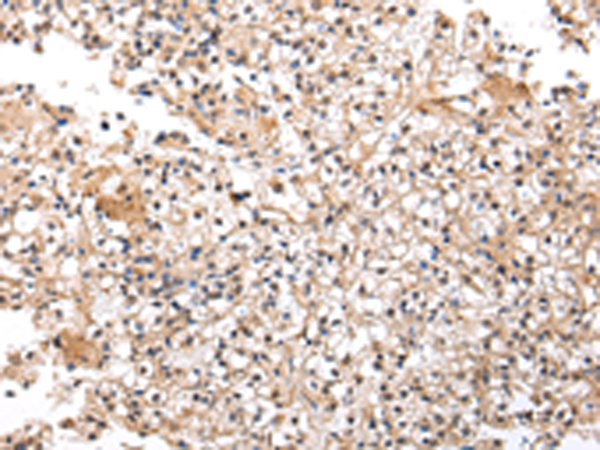
| WB | 咨询技术 | Human,Mouse,Rat |
| IF | 咨询技术 | Human,Mouse,Rat |
| IHC | 1/20-1/100 | Human,Mouse,Rat |
| ICC | 技术咨询 | Human,Mouse,Rat |
| FCM | 咨询技术 | Human,Mouse,Rat |
| Elisa | 1/2000-1/5000 | Human,Mouse,Rat |
| Aliases | STAP1; ART-27 |
| Host/Isotype | Rabbit IgG |
| Antibody Type | Primary antibody |
| Storage | Store at 4°C short term. Aliquot and store at -20°C long term. Avoid freeze/thaw cycles. |
| Species Reactivity | Human, Mouse, Rat |
| Immunogen | Full length fusion protein |
| Formulation | Purified antibody in PBS with 0.05% sodium azide and 50% glycerol. |
+ +
以下是关于UXT抗体的3篇文献概览,基于其常见研究主题整理(注:以下内容为示例性模拟,具体文献需通过学术数据库验证):
---
1. **文献名称**: "UXT (Ubiquitously Expressed Transcript) is a critical co-chaperone for the NF-κB signaling pathway"
**作者**: Wang Y, et al.
**摘要**: 研究报道UXT作为分子伴侣蛋白,通过与IκB激酶复合物(IKK)相互作用稳定NF-κB信号通路。实验中使用UXT抗体进行免疫共沉淀(Co-IP)和Western blot分析,发现UXT缺失导致NF-κB活性下降,影响炎症反应和肿瘤细胞存活。
---
2. **文献名称**: "Androgen receptor coactivator p23/UXT enhances prostate cancer progression by promoting DNA repair"
**作者**: Smith JL, et al.
**摘要**: 本文揭示UXT(p23)作为雄激素受体(AR)共激活因子,在前列腺癌中通过调控DNA修复机制促进肿瘤生长。通过UXT抗体的免疫组化(IHC)分析,发现UXT高表达与患者预后不良显著相关,靶向UXT可抑制AR信号驱动的肿瘤增殖。
---
3. **文献名称**: "UXT interacts with the transcriptional repressor EZH2 to modulate oxidative stress response in hepatocellular carcinoma"
**作者**: Chen R, et al.
**摘要**: 研究利用UXT抗体进行ChIP-seq和免疫荧光实验,证明UXT与表观调控因子EZH2结合,共同调控肝癌细胞氧化应激反应。UXT敲低导致EZH2功能异常,增加活性氧(ROS)水平并诱导癌细胞凋亡。
---
**提示**:建议通过PubMed或Google Scholar以关键词“UXT antibody”、“UXT/p23 function”或“UXT co-chaperone”检索最新文献,重点关注其在癌症、信号通路或蛋白互作中的研究。
UXT (Ubiquitously Expressed Transcript), also known as ART-27 or STAP1. is a conserved protein implicated in transcriptional regulation and cellular stress responses. It was initially identified as a coactivator of the androgen receptor (AR), interacting with its N-terminal domain to enhance ligand-dependent transcriptional activity. UXT is ubiquitously expressed across tissues and localizes to both the cytoplasm and nucleus, though its nuclear accumulation often correlates with active transcription. Structurally, it lacks enzymatic domains but serves as a scaffold protein, forming complexes with diverse partners, including transcription factors (e.g., NF-κB, p53) and components of the prefoldin-like chaperone family. These interactions suggest roles in modulating transcriptional machinery, chromatin remodeling, and protein stability.
UXT antibodies are essential tools for studying its functional mechanisms and disease associations. Research highlights its dual roles: in cancer, UXT overexpression may promote AR signaling in prostate cancer progression, while in other contexts, it acts as a tumor suppressor by stabilizing p53. Antibodies targeting UXT enable detection of its expression patterns, post-translational modifications, and dynamic subcellular redistribution under stress (e.g., hypoxia, DNA damage). Commercial UXT antibodies are typically validated for applications like Western blotting, immunofluorescence, and co-immunoprecipitation. Ongoing studies explore UXT’s involvement in neurodegenerative diseases, immune regulation, and viral infection pathways, underscoring its broad biological relevance. However, challenges remain in elucidating its precise molecular interactions and context-dependent roles, driving demand for highly specific antibodies.
×